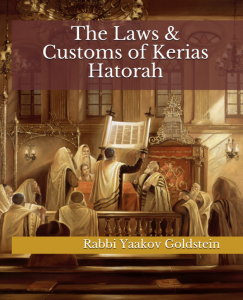The Torah reading of Parshas Ki Seitzei:
If one missed Parshas Zachar: If one did not hear the reading of Amaleik on Parshas Zachar he can still fulfill his Biblical obligation through hearing the Torah reading of Amaleik in Parshas Ki Seitzei.[1] [In such a case however one must have in mind to fulfill the Mitzvah of remembering Amaleik upon hearing the reading. Some Poskim[2] write that one is to tell the Baal Korei to have in mind to fulfill his obligation.]
Zeicher/Zecher:[3] There is dispute amongst Poskim[4] as whether one is to read Zeicher Amaleik or Zecher Amaleik. Practically one is to read both.[5] By the reading of Parshas Zachar and Parshas Ki Seitzei one reads first Zeicher and then Zecher. By the reading on Parshas Beshalach and Purim one reads first Zecher and then Zeicher.[6] Our custom is to only repeat the word Zeicher and Zecher, however others have the custom to repeat the entire verse twice.[7] [One is to repeat Zeicher Zecher in both Shevii and the Haftorah.[8]]
Noise making by Zachar:[9] Many Gedolei Yisrael have protested against noise making at the end of the reading of Amaleik.[10]
In a leap year is one to fulfill his obligation of Zachar also with the reading of Parshas Ki Seitzei? Some Poskim[11] rule that in the year preceding a leap year, asides for Parshas Zachar, one is to intend to fulfill his obligation of remembering Amaleik also during the reading of Parshas Ki Seitzei.[12] Others[13] however hold it is not necessary to do so.[14]
|
________________________________________
[1] Aruch Hashulchan 685:5; Hisvadyos 1989 2 p. 442-446 printed in Shaar Hamoadim Adar 46-47
[2] Har Tzevi 1:58
[3] Shaareiy Halacha Uminhag 2:288; Ketzos Hashulchan 84 footnote 22 and glosses to volume 3 (p.74b)
[4] Brought in M”B 685:18 [The Rebbe in Shaareiy Halacha Uminhag ibid writes his source is from the Mesorah] Some Poskim rule the main Nusach is with a Tzeirei. [Betzeil Hachachmah 6:50; Piskeiy Teshuvos 685:9] Others rule the main Nusach is a Segal. [Maaseh Rav 134 that so was the custom of the Gra; Ketzos Hashulchan 84 footnote 22. In the glosses to volume 3 (p.74b) he proves that this was also the opinion of the Tzemach Tzedek] In conclusion the Rebbe and Ketzos Hashulchan ibid rule that by Beshalach the main Nusach is with a Tzeirei while by Ki Seitzei the main Nussach is with a Segal. Nevertheless, we still read both Nuschaos as will be explained.
The saying of the Toras Chesed: The Ketzos Hashulchan ibid quotes the Toras Chesed to say “Zecher, Zeicher, the main thing is to blot them out properly”.
[5] M”B ibid; Ketzos Hashulchan ibid writes that those which are meticulous would read it one time with a Tzeirei and one time with a Segal. Meaning that by the reading of Beshalach and Ki Seitzei they would read it one way by Shevi and the second way by Maftir, while by Purim and Parshas Zachar they would repeat the verse twice. In the glosses to volume 3 (p.74b) he concludes that this is the custom, to read both Zeicher and Zecher and so was the directive of Rav Shneur Zalman of Lublin, the author of Toras Chesed. To note however that there he mentions that the Baal Korei in Lubavitch stated they would read by Beshalach only with a Tzeirei, and by Ki Seitzei only with a Segal.
[6] So concludes the Rebbe ibid, Ketzos Hashulchan ibid based on the Sefer Boneh Yerushalayim which is Meyuchas to the Alter Rebbe that by Beshalach the main Nusach is with a Tzeirei while by Ki Seitzei the main Nussach is with a Segal. Nevertheless we still read both Nuschaos as ruled the Toras Chesed.
[7] See Piskeiy Teshuvos 685:9
[8] Otzer Minhagei Chabad p. 18 unlike the custom recorded in Ketzos Hashulchan 85 footnote 22 and the supplements in the back of the Sefer that one is to read Zeicher by Shevi and Zecher by Maftir.
[9] Hiskashrus 109 and 1025; Yalkut Yosef 5:259
[10] Seemingly the reason for this is due to a Hefsek, interval, in the reading or between the reading and the blessing.
[11] Maharam Shick Mitzvah 605
[12] As after 12 months have passed without remembering Amaleik it is considered as if one has forgotten it. [ibid]
[13] Divreiy Yoel 33
[14] As the extra month during a leap year is all considered part of that year and hence it is not considered that more than 12 months have passed. [ibid]



Leave A Comment?
You must be logged in to post a comment.